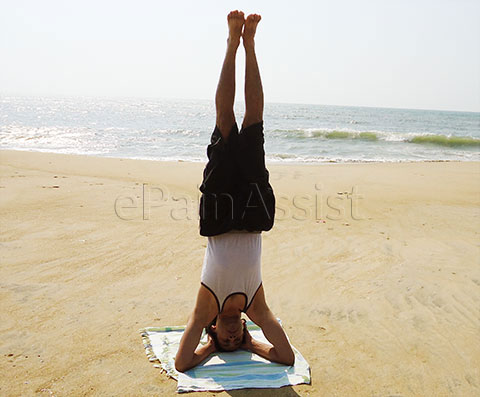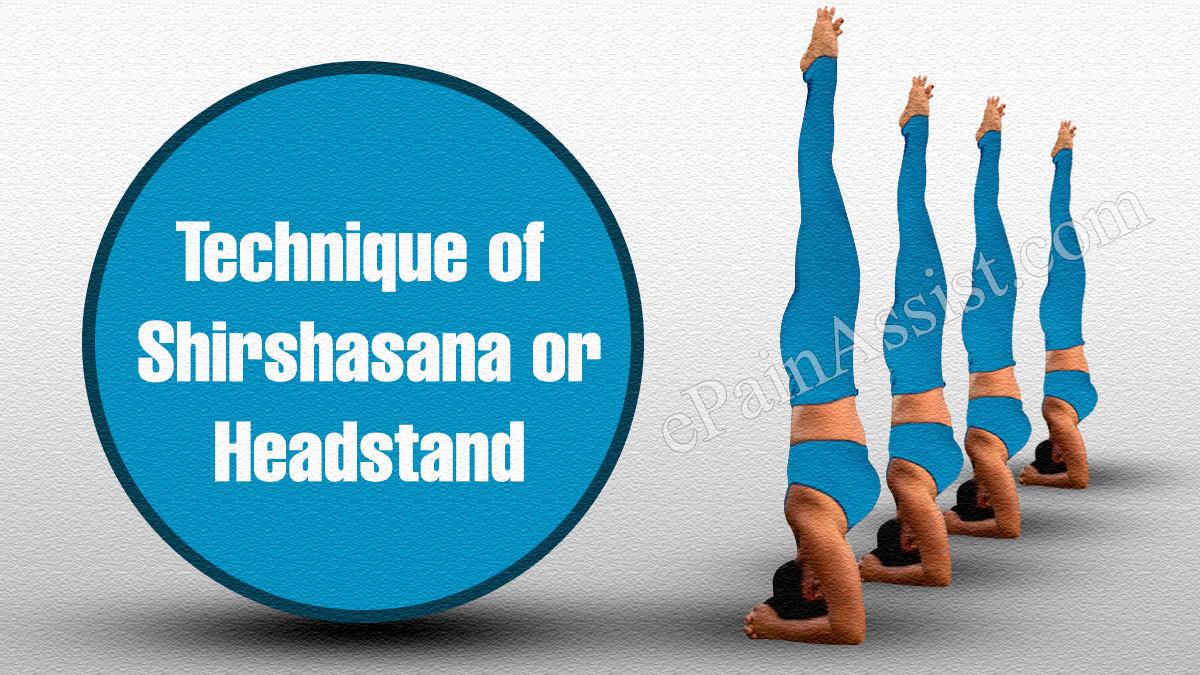Shirshasana (Headstand)
Shirshasana or headstand is one of the pose of yoga and is also known as the king of all yoga asanas or yoga postures. Headstand, when done correctly and learned under the guidance of a yoga expert, is very beneficial.
As Shirshasana or headstand comprises of balancing the body on the head, it helps in strengthening the neck muscles, improves your ability to balance your body, along with improving blood circulation to your head which in turn results in many other benefits. Headstand or Shirshasana is contraindicated in people suffering from high blood pressure or having neck problems, palpitations, glaucoma, retinal detachment, conjunctivitis, brain disease/injury, menstruation, obesity, pregnancy, neck and back injury.
Health Benefits of Shirshasana/Head Stand

- Headstand improves the overall blood circulation of the body and especially the blood circulation to the head, which in turn helps in improving memory and concentration.
- Regular practice of Shirshasana or headstand helps in reducing hair loss as this asana increases the blood circulation to the scalp.
- Shirshasana or headstand helps in toning the digestive system.
- Headstand also improves your ability to balance your body.
- Shirshasana helps in relieving the pressure from the veins in the legs, so individuals suffering from varicose veins will find great relief by practicing this asana regularly.
- Shirshasana also benefits people suffering from insomnia or having other sleep problems.
- Shirshasana also helps in alleviating problems related to back pain.
- Headstand provides rest to the heart by using gravity to encourage venous return.
- Headstand or Shirshasana stimulates deeper breathing, thereby strengthens the lungs and increases your energy levels.

Technique of Shirshasana/Headstand
Note for Beginners: It is advisable to try doing Shirshasana or headstand using the wall as a support so as to prevent yourself from landing on your back, as there is a high possibility of that happening during the initial phase of trying to master this asana.
Begin with the child’s pose and follow these eight steps to practice the headstand properly:
- Kneel down and grasp your elbows with your hands.
- Keep your elbows where they are and intertwine your fingers in front of you so that the elbows and hands form an equilateral triangle.
- Position the uppermost part of your head on the floor with the back of your head placed against your fingers.
- Extend your knees and raise your hips so that your body now resembles an inverted V. Make sure that your weight is equally distributed between your head/arms and the feet.
- While keeping your knees as straight as possible, walk with little steps thereby bringing your feet as close as you can to your head. This will result in shifting of weight from the feet onto the head/arms. Make sure to keep your back as straight as possible to avoid arching of your neck.
- Bend your knees while keeping them close to your chest and your feet close to your buttocks. Maintain your balance by shifting your hips.
- Continue keeping your knees bent and slowly point them upwards.
- At this point, slowly straighten your legs while keeping your feet relaxed. Make sure that your head is supporting not more than 10% of your body weight with the rest of the weight supported by the elbows. Initially you can hold this pose for 5 seconds and gradually increase it to 10 to 15 minutes.
Slowly, using constraint, revert back into the child’s pose and retrace the above steps in reverse order. Take deep breaths and relax on your back.
Inversion Therapy Using Inversion Table
Many of us would want to avail the benefits of Headstand or Shirshasana, but challenges of being able to do it successfully would put off most people thereby forgoing all the benefits which one could have otherwise gotten from it, but there is no need to be disappointed as there is an alternative to shirshasana/headstand, which offers almost all of the benefits provided by Shirshasana except the body balance and strengthening of the Neck Muscles and this can be achieved by Inversion Therapy using the Inversion Table.
What is Inversion Therapy?
Inversion therapy is a procedure which comprises of hanging the body upside down using a inversion table, so that there is gentle traction applied to the spine. This therapy was invented in 400 B.C. by Hippocrates (the father of medicine). Inversion therapy benefits by reducing back pain and is also helpful in reversing the effects of aging on the spine.
The concept of hanging the body upside down for improving health was discovered centuries ago. For example, in yoga, the headstand position is an asana which involves a pose where you have to stand on your head and has been in use by yoga practitioners for temporarily reversing the direction of gravity. The thing to remember is not everyone can do headstands and it also does not relieve compression. Here’s where the inversion therapy comes in. Inversion therapy is an easier method where one can achieve almost all the benefits of headstands simply by using inversion table.
As the time goes on, due to the effect of gravity, there is gradual flattening of the spinal discs. The function of these discs is to absorb shock between the vertebrae. Due to the compressive effect of gravity, stress, weak stomach muscles and back, lack of exercise etc. all this leads to back pain. Through inversion therapy using inversion table, these gravitational effects can be gradually reduced. Individuals often begin to feel its benefits in a couple of weeks itself. Not only does inversion therapy using inversion table helps with back pain, it also promotes good health by correcting spinal alignment problems, removing tension headaches, reducing hemorrhoids, relieving the discomfort of varicose veins, and also increasing mental prowess. Many individuals, as they age, suffer from prolapsed internal organs due to the years of the downward pull of gravity and inversion therapy helps in reversing those effects by using gravity to naturally correct and align the body. It helps in stretching, elongating the body and spine, increases blood flow to the brain, inverts and repositions the internal organs, and relieves stress from the heart.
Inversion therapy using inversion table is contraindicated in individuals who are overweight, having a history of stroke, acute back injuries, hypertension, bone disease, pregnancy, detachment of retina or other eye disorders.
Benefits of Inversion Therapy Using Inversion Table, An Alternative to Headstand or Shirshasana
- Inversion Therapy alleviates back pain.
- Nourishes the spinal discs.
- Provides functional fitness.
- Inversion Therapy helps in strengthening the core muscle groups without straining the spine.
- Helps in recovering from high intensity workouts.
- Inversion Therapy soothes overworked muscles.
- Inversion Therapy using Inversion Table helps in strengthening the ligaments.
- Inversion Therapy relieves stress.
- Inversion Therapy promotes blood circulation.
- Improves orientation.
- Helps in ageing gracefully.
- Inversion Therapy relieves mental disorders such as anxiety, depression, and insomnia.
In headstand or shirshasana the body’s weight is borne on the hands/arms/elbows, whereas in inversion therapy using inversion table, all the joints in the body bear the weight in an equal and opposite manner and are in a same position of joint alignment. In headstand, the additional benefits which a person gets are better body balance and strengthening of the neck muscles.
To sum up, the continuous and gradual pull of gravity on the body is a powerful force which has negative effects on the human body. Inversion therapy using inversion table helps in gradually reversing the effects of gravity and aging by stretching and elongating the body. When done in a proper and correct manner, inversion therapy is very beneficial. Regular inversion with the help of inversion table helps in relieving back and neck pain along with other health benefits such as rejuvenation of mind and body along with relieving mental stress and improving balance and coordination.
